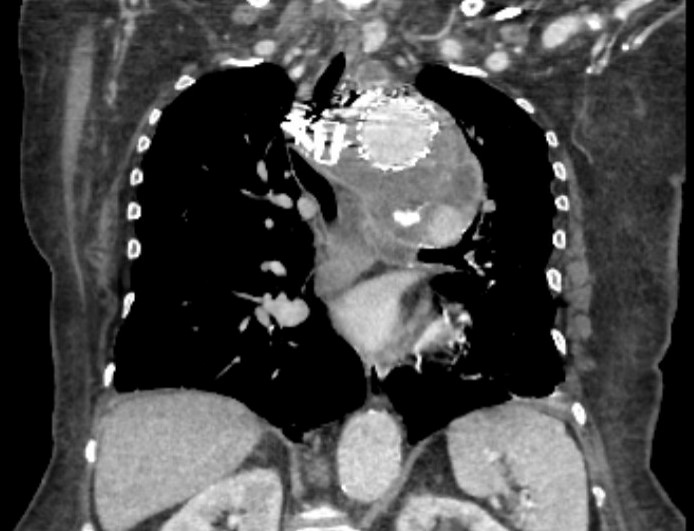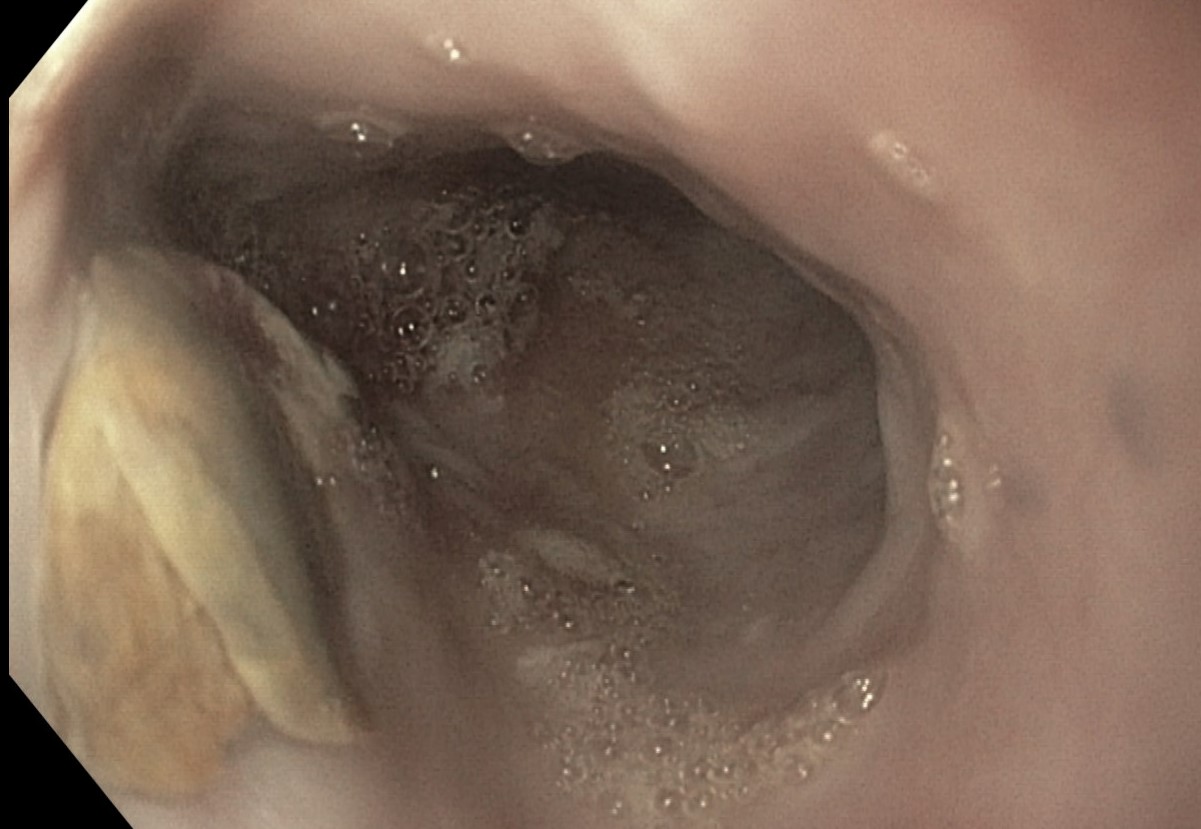Monday Poster Session
Category: GI Bleeding
P3148 - Hematemesis Due to Aortic Arch Peri-Graft Endoleak Associated Esophageal Ulceration
Monday, October 27, 2025
10:30 AM - 4:00 PM PDT
Location: Exhibit Hall
- MH
Michael Harring, MD
St. Luke's University Health Network
Bethlehem, PA
Presenting Author(s)
Michael Harring, MD
St. Luke's University Health Network, Bethlehem, PA
Introduction: Aorto-esophageal fistula is a rare, yet life-threatening etiology for massive upper gastrointestinal bleeding caused by an aberrant connection between the esophagus and aorta often occurring in the setting of an ascending aortic aneurysm, postoperative complication, erosive malignancy or foreign body ingestion. The classic triad includes midthoracic pain, sentinel arterial hemorrhage and exsanguination after a symptom-free interval. Endoscopy is necessary to rule out alternative sources of bleeding with urgent surgical intervention recommended.
Case Description/
Methods: An 81 yo F with history of prior tobacco use and aortic insufficiency with a large ascending aortic aneurysm status post thoracic endovascular aortic repair (TEVAR) complicated by persistent endoleak requiring embolization who presented to the hospital due to fevers and myalgias with infectious workup revealing Listeria monocytogenes bacteremia. She had multiple episodes of hematemesis during hospitalization with hemoglobin down trending from 10.4 to 8.3 leading to GI consultation and EGD while inpatient without previous evaluation. Prior to procedure, patient underwent CT on admission notable for evidence of endoleak adjacent to the proximal and distal aortic endograft without significant overall change in size of the excluded sac. EGD revealed an ulcer in the mid esophagus with clean base overlying an area of extrinsic compression with concern that this correlated to the site of known ascending aortic aneurysm and endoleak. Her case was discussed with thoracic surgery who recommended transfer to outside institution where she primarily received her thoracic surgical care. Unfortunately, four days after transfer, while ongoing diagnostics were taking place with plan for surgery later that week, she had a recurrent episode of hematemesis and lost consciousness while in her hospital room. CPR was initiated immediately, but soon after patient was pronounced dead with concern that rupture of her thoracic aneurysm was cause of death.
Discussion: Postoperative complications can lead to serious consequences with careful history taking necessary to deliver optimal care. Despite high technical success, postoperative perigraft leaks remain widely reported. Pressure necrosis from extrinsic compression of the aortic aneurysm and endoleak can occur as in this case, which serves to highlight the importance of multidisciplinary communication as well as careful review of imaging prior to procedural investigation to ensure thorough examination.

Figure: CT chest coronal image of endoleak surrounding aortic endograft

Figure: Mid esophageal ulceration overlying extrinsic compression
Disclosures:
Michael Harring indicated no relevant financial relationships.
Michael Harring, MD. P3148 - Hematemesis Due to Aortic Arch Peri-Graft Endoleak Associated Esophageal Ulceration, ACG 2025 Annual Scientific Meeting Abstracts. Phoenix, AZ: American College of Gastroenterology.
St. Luke's University Health Network, Bethlehem, PA
Introduction: Aorto-esophageal fistula is a rare, yet life-threatening etiology for massive upper gastrointestinal bleeding caused by an aberrant connection between the esophagus and aorta often occurring in the setting of an ascending aortic aneurysm, postoperative complication, erosive malignancy or foreign body ingestion. The classic triad includes midthoracic pain, sentinel arterial hemorrhage and exsanguination after a symptom-free interval. Endoscopy is necessary to rule out alternative sources of bleeding with urgent surgical intervention recommended.
Case Description/
Methods: An 81 yo F with history of prior tobacco use and aortic insufficiency with a large ascending aortic aneurysm status post thoracic endovascular aortic repair (TEVAR) complicated by persistent endoleak requiring embolization who presented to the hospital due to fevers and myalgias with infectious workup revealing Listeria monocytogenes bacteremia. She had multiple episodes of hematemesis during hospitalization with hemoglobin down trending from 10.4 to 8.3 leading to GI consultation and EGD while inpatient without previous evaluation. Prior to procedure, patient underwent CT on admission notable for evidence of endoleak adjacent to the proximal and distal aortic endograft without significant overall change in size of the excluded sac. EGD revealed an ulcer in the mid esophagus with clean base overlying an area of extrinsic compression with concern that this correlated to the site of known ascending aortic aneurysm and endoleak. Her case was discussed with thoracic surgery who recommended transfer to outside institution where she primarily received her thoracic surgical care. Unfortunately, four days after transfer, while ongoing diagnostics were taking place with plan for surgery later that week, she had a recurrent episode of hematemesis and lost consciousness while in her hospital room. CPR was initiated immediately, but soon after patient was pronounced dead with concern that rupture of her thoracic aneurysm was cause of death.
Discussion: Postoperative complications can lead to serious consequences with careful history taking necessary to deliver optimal care. Despite high technical success, postoperative perigraft leaks remain widely reported. Pressure necrosis from extrinsic compression of the aortic aneurysm and endoleak can occur as in this case, which serves to highlight the importance of multidisciplinary communication as well as careful review of imaging prior to procedural investigation to ensure thorough examination.

Figure: CT chest coronal image of endoleak surrounding aortic endograft

Figure: Mid esophageal ulceration overlying extrinsic compression
Disclosures:
Michael Harring indicated no relevant financial relationships.
Michael Harring, MD. P3148 - Hematemesis Due to Aortic Arch Peri-Graft Endoleak Associated Esophageal Ulceration, ACG 2025 Annual Scientific Meeting Abstracts. Phoenix, AZ: American College of Gastroenterology.
